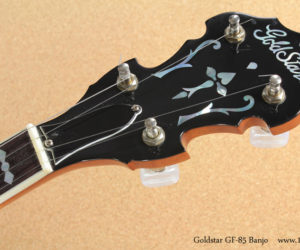This is a wild 2008 Gold Sparkle PRS McCarty Archtop II! Custom built for a prominent Canadian touring band, this unusual instrument has been well maintained and is ready for the stage or set. Paul Reed Smith introduced the McCarty Archtop and Archtop II in 1998, but discontinued it in 2000. Most of the McCarty archtops have carved mahogany back and mahogany sides, and spruce top. This Archtop II,(and its silver-sparkle sister) has carved maple top and back, and maple sides.
MORE →SOLD
This is a spectactular 2008 Silver Sparkle PRS McCarty Archtop II! Custom built for a touring band, this unusual instrument has been well maintained and is ready for the stage or set. Paul Reed Smith introduced the McCarty archtop in 1998, and this version was produced until 2000.
MORE →Here is a very clean 2011 Martin 000-18. The 000-18 is a fairly plain, straightforward, extremely competent guitar and has been produced by Martin since 1921 (except for 1932 and 1933).
A little brighter than rosewood models, the smaller body size adds to comfort and a more balanced tone, without the potential for ‘boominess’ often found with dreadnought guitars.
MORE →Summer is here and banjo music is in the air! Here are five Bluegrass Banjos under One Thousand Dollars.
I’m always in short supply for good, playable, used banjos in the under $1000 price range but some nice trade-in banjos came in this week.
All 5 banjos below are ideal for the intermediate player who wants a good sounding banjo but is not ready to move up to a professional instrument.
MORE →Here’s a wonderful 1962 Fender Super Amplifier.
The need for volume had always been there. By 1962, technology was catching up and significantly more power was available to the working musician. The Super Amp nudged 40 watts into two 10 inch speakers.
MORE →Here’s a lovely 1960 Fender Champ Amplifier. After having its name shortened from Champion and getting a boost to 5 watts!) in 1955, the Champ continued production and was very popular with beginner musicians.
Or, it was popular until massively more powerful amps became available, and the demand for small amps fell off.
MORE →




